A Scandinavian Airlines (SAS) flight was forced to make an emergency landing in Copenhagen after a mouse leaped out of a passenger’s in-flight meal and into the aircraft aisle. Passengers deplaned and boarded a new aircraft to their final destination.
While not seemingly dangerous, rodents, like mice, pose severe safety risks to aircraft operations, as the animals tend to chew through electrical wiring.
Ratatouille at 35,000 Feet

The incident happened onboard a Wednesday afternoon SAS flight, SK4683, from Oslo, Norway (OSL), to Malaga, Spain (AGP) onboard a SAS A320neo.
According to flight tracking data, the flight took off on-time from Oslo at 2:05 p.m. local time and turned southwest towards the Netherlands and France. After about 30 minutes of flight time, the aircraft reached its cruising altitude of 36,000 feet and flight attendants began passing out in-flight meals to passengers.
However, for one unfortunate SAS traveler, a sneaky mouse reportedly leaped out of her meal and ran away down the aircraft aisle.
Sitting next to the woman whose meal was infested with the rodent, passenger Charle Borrested took to Facebook to share his perspective of the mouse invasion:
“Believe it or not. A lady next to me here at SAS opened the food and out jumped a mouse. Now we have turned around and landed at CPH for flight changes.”
In addition, Borrestad said that he pulled his socks over the legs of his pants to prevent the mouse from crawling up. He noted that his fellow passengers “were not stressed at all” and most stayed calm.
The cabin crew was quickly made aware of the mouse’s presence onboard the aircraft, who then informed the captain of the situation. The pilots decided to divert to Copenhagen Airport due to the safety threat the mouse posed to the crucial electrical systems onboard.

The aircraft circled once above northern Denmark before descending over the country and landing safely at CPH at 3:48 p.m, around an hour and a half after takeoff.
Passengers exited the aircraft and boarded a new one, which completed the flight from Copenhagen to Malaga. In total, the mouse caused a delay of just over 2 hours.
SAS’s Response
In a statement, SAS spokesperson Oyster Schmidt commented: "This is something that happens extremely rarely. We have established procedures for such situations, which also include a review with our suppliers to ensure this does not happen again."
Another SAS spokesperson told PEOPLE: “We [SAS] made a very normal landing in Copenhagen in order to change aircraft and catering — which is a fully normal procedure when a rodent is found onboard."
"In these cases, we have very clear procedures to follow, including full inspection of the aircraft and of all our suppliers’ processes to see what needs to be improved or changed in order to avoid scenarios like these," the statement continued. "This inspection and investigation are now initiated."
The airline has initiated an investigation into the incident and says suppliers of in-flight meals will undergo a thorough review.
Why are mice so dangerous to Aeroplanes?

While not dangerous to humans, mice and other rodents pose severe safety threats to aircraft. This is because mice love to chew things, like electrical wiring.
When mice enter the outer shell of an airplane where the electrical wiring runs, they often partially chew wires for the insulation, which they then use to build nests. This creates dangerous environments for possible short circuits, which can easily lead to explosive fires.
These fires may be located in places only rodents can access, not humans. This creates the danger that the fire would not be extinguished in flight, not a situation pilots want at 35,000 feet in the sky.
Situations with live animals sneaking onboard aircraft through in-flight meals are scarce. However, situations involving rodents have occurred in the past. In 2017, a British Airways flight from London to San Francisco was delayed by four hours after a rat was found roaming the cabin before departure.
When Will the Boeing 777X Enter Service? Delays, Certification, and 2027 Outlook » Austrian Airlines Abruptly Terminates Wet Lease with Braathens Regional Airlines » Southwest and Turkish Airlines Unveil 2026 Partnership »
Comments (0)
Add Your Comment
SHARE
TAGS
NEWS BreakingNewsInflightIncidentMouseInMealEmergencyLandingAirlineSafetySASAirlinesPassengerSafetyFlightEmergencyTravelNewsUnexpectedEventRodentProblemAviationNews.RECENTLY PUBLISHED
 Should Students Have Homework? Better After-School Balance
Is homework bad for students? Explore learning benefits, stress, sleep, and smarter workload limits, so after-school time stays balanced.
STORIES
READ MORE »
Should Students Have Homework? Better After-School Balance
Is homework bad for students? Explore learning benefits, stress, sleep, and smarter workload limits, so after-school time stays balanced.
STORIES
READ MORE »
 Air Canada Rouge to Launch Boeing 737 MAX 8 Operations
Air Canada has officially confirmed a strategic shift for its leisure subsidiary, Air Canada Rouge, announcing that Boeing 737-8 (MAX 8) operations are slated to begin in late Q1 2026. The move marks the beginning of an ambitious year-long transition that will see Rouge evolve into an all-Boeing 737 operator.
ROUTES
READ MORE »
Air Canada Rouge to Launch Boeing 737 MAX 8 Operations
Air Canada has officially confirmed a strategic shift for its leisure subsidiary, Air Canada Rouge, announcing that Boeing 737-8 (MAX 8) operations are slated to begin in late Q1 2026. The move marks the beginning of an ambitious year-long transition that will see Rouge evolve into an all-Boeing 737 operator.
ROUTES
READ MORE »
 Qanot Sharq Takes Delivery of First Airbus A321XLR to Transform Central Asian Long Haul Travel
Uzbekistan’s premier private carrier, Qanot Sharq, has officially taken delivery of its first Airbus A321XLR. The delivery, which took place today at the Airbus facility in Hamburg, makes Qanot Sharq the launch operator for the ultra-long-range narrow-body in the Commonwealth of Independent States (CIS) and Central Asia.
ROUTES
READ MORE »
Qanot Sharq Takes Delivery of First Airbus A321XLR to Transform Central Asian Long Haul Travel
Uzbekistan’s premier private carrier, Qanot Sharq, has officially taken delivery of its first Airbus A321XLR. The delivery, which took place today at the Airbus facility in Hamburg, makes Qanot Sharq the launch operator for the ultra-long-range narrow-body in the Commonwealth of Independent States (CIS) and Central Asia.
ROUTES
READ MORE »



